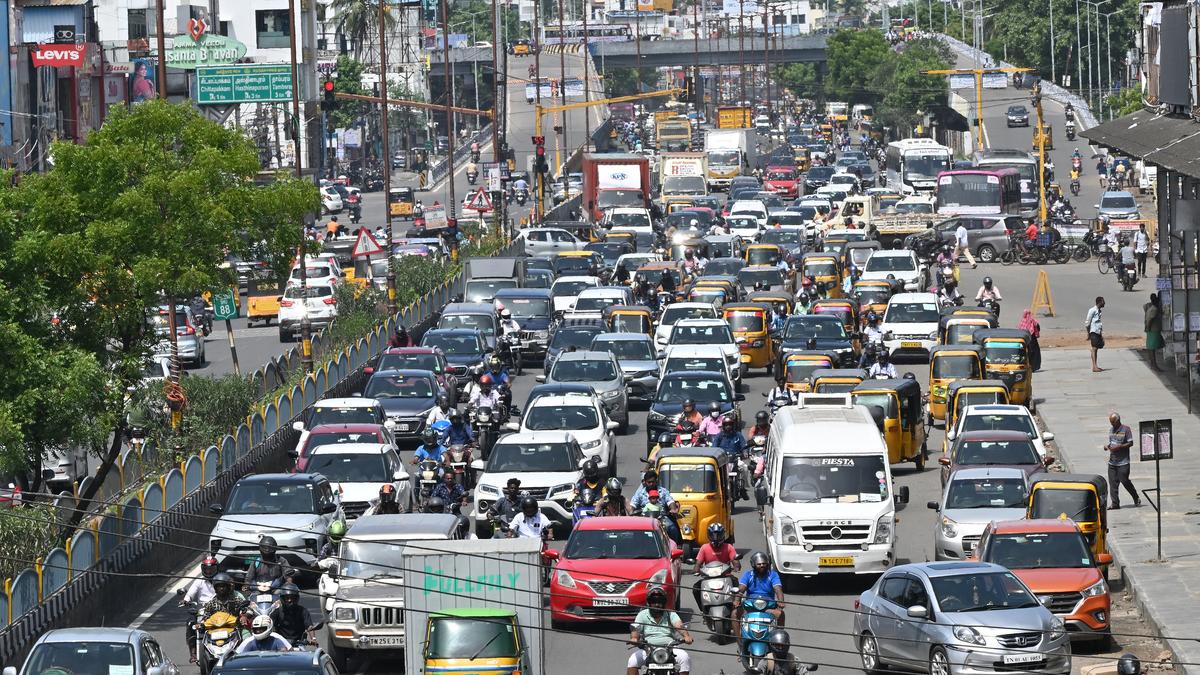
It is a nightmare for commuters taking GST Road at peak hours
The Hindu
It is a nightmare for commuters taking GST Road at peak hours
Last Sunday, heavy traffic choked the Grand Southern Trunk (GST) Road as thousands of families returned to the city ahead of the reopening of schools. And a large number of vehicles are caught in the traffic on this road at peak hours every day. From Meenambakkam to Tambaram and from Perungalathur to Singaperumal Koil, many motorists and public transport passengers are often stuck in snarls for hours. Those using cars or two-wheelers have to move bumper to bumper every day.
Besides being the gateway to the southern and central districts, the GST Road links the surrounding regions. As many commercial establishments and educational institutions are located on the road, a large number of commuters use it daily. A new bus terminus was opened at Kilambakkam on the GST Road for easing traffic congestion in the city limits. Omni-buses are not allowed to enter the city. But they continue to ply in the city in the early morning and late night hours. Traffic congestion is more at the Peerkankaranai junction on the Tambaram-Perungalathur Road. Anand Venkat, a businessman from Chromepet, says, “Even after new bridges were built, we face difficulties daily owing to heavy traffic from Chromepet to Tambaram and from Perungalathur to Singaperumal Koil. People who use their own vehicles will have to wait for long in the traffic.”
Social activist David Manohar says, “We encounter heavy traffic from the Alandur Metro Rail station. The carriageway has shrunk at places near the old airport at Pallavaram, with shops and street-vendors encroaching on the pedestrian path. Pedestrians are forced to walk on the carriageway, hindering the free flow of traffic.”
Many road-users say the traffic flow is affected immediately after they get down from the bridge near the airport towards Pallavaram. From there, both sides of the road are encroached upon by shops. It is tough to reach the bridge connecting the Pallavaram- Thoraipakkam Radial Road.
S. Vinodh, a regular commuter from Pallavaram, says, “At peak hours, there is traffic congestion from the Pallavaram bus stand, extending from Lakshmi Nagar, a shopping zone, up to the airport. The roads connecting the two lanes of the GST Road — one near the Super Saravana Stores and the other near the post office — are closed. The closure forces people to take the flyovers for turning around, and the flyovers get jammed. There are no policemen at the major traffic spots. During Muhurtham days, the traffic from or to the Pallavaram bus stand moves at a snail’s pace, as there is bumper-to-bumper traffic even beyond Chromepet.”
At Chromepet, all buildings were allowed to convert their stilt car parking into retail outlets. Only three textile showrooms have parking lots. So the customers of shops without parking lots park their vehicles on the carriageway, some residents say.
“After a brief spell of rain, the GST Road in this part gets flooded from three inlets of the Pallavaram lake. The stretch has been taken over by commercial outlets. Sometimes, flooding causes traffic snarls, with vehicles queuing up five km on either side. Many complaints have been filed and officials have visited the area, but no action has been taken by the departments concerned,” says Mr. David Manohar.

After a long, tiring day all we want is to jump right on our cosy beds and rest comfortably on our soft, fluffy pillows, right? Pillows are not quite appreciated as much as electric cars or air-fryers, for instance. Pillows are a wonderful man-made creation that has improved the lives and sleep of people across the globe. Did you know ages ago people used to rest their heads on a HARD ROCK? So how did humans go from sleeping on stones to cosy, fluffy and soft pillows today? Let’s get into the origin of your everyday pillows!

As the November 30 deadline nears for installing vehicle location tracking devices (VLTD) and emergency panic buttons in public service and nationally permitted goods vehicles in Karnataka, transport unions representing cab, bus, and truck operators are urging the government to reconsider the mandate. They argue that the high cost of these devices and a lack of awareness have made it difficult for many vehicle owners to comply with the requirement.









